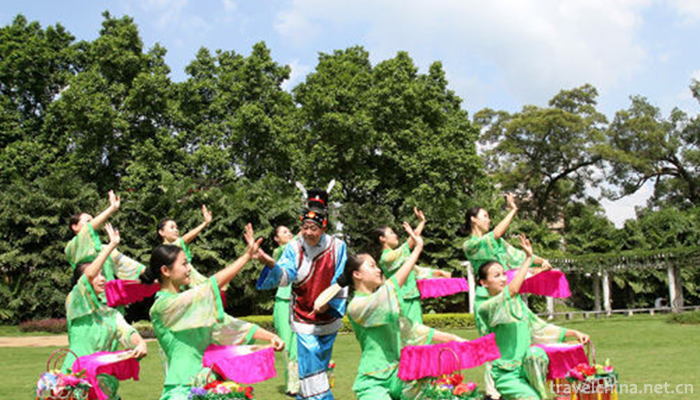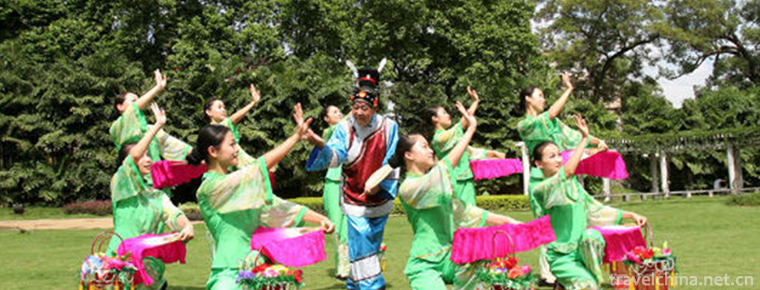Longyan tea lamp
Longyan tea lamp
Longyan tea-picking lamp, also known as tea-picking and butterfly-beating, is a popular folk dance and singing in Longyan city and countryside. It integrates rap, opera and dance into a comprehensive form of mass recreational activities. Tea-picking lamps have been popular in Meishan Village since the mid-19th century. Tea-picking music and war drums were introduced from Guangdong by the 17th ancestor of Meishan Linshi. Dance shows the working scene of tea picking season: led by the tea mother, the village aunts follow Wu Sheng and the male ugly in the music of tea picking gongs and drums, and come to the tea garden to pick spring tea .
In November 2005, Longyan Tea-picking Lamp was announced by Fujian Provincial Government as a provincial intangible cultural heritage protection project. On December 03, 2014, Longyan Tea-picking Lamp was selected into the "Fourth National Class of Representational Items of intangible cultural heritage" issued by the State Council.
Development history
The tea picking lantern began to be popular in the United States since the mid nineteenth Century. The music of the tea picking lantern was mainly based on the music uploaded by the ancestors, and absorbed the music essence of the music flowing into Guangdong by the old artists. In the eighth year of Xianfeng in Qing Dynasty (1858 A.D.), the Chen family of Longyan performed a tea-picking lamp at a large-scale event. The lyrics and tunes transcribed at that time (now kept in Longyan Museum) .
In 1952, after being processed and sorted out by Longyan County Cultural Museum, tea lanterns organized rehearsals to attend the first rural performance in Fujian Province and won awards. Later, it was adapted by Jinjiang Literature and Works Group to participate in the East China regional performance, and produced documentaries and copies for distribution all over the world.
At the end of 1953, the Chinese Youth Art Troupe took the tea lantern to Romania for the third International Youth Festival of Peace and Friendship, and won the silver medal.
In the 1960s and 1970s, the music of tea-picking lanterns was used by the Central People's Broadcasting Station and Fujian People's Broadcasting Station as the prelude of "Broadcasting to Rural Areas" for decades .
In 1981, the Ministry of Culture of the People's Republic of China submitted the original music score of Meishan village tea lantern to the United Nations Educational, Scientific and Cultural Organization for the record. In the same year, it was collected as an "oral cultural heritage" by the United Nations Educational, Scientific and Cultural Organization.
In November 2005, Longyan Tea-picking Lamp was announced by Fujian Provincial Government as a provincial intangible cultural heritage protection project .
On June 27, 2008, the Longyan Tea Lantern Seminar held its founding meeting at Meishan Primary School, Subanxiang, Xinluo District. The conference adopted the statute of the Seminar and the list of its members. Longyan Tea Lamp Research Association aims to mobilize all sectors of society to further tap, collect, organize and promote the artistic charm of "Longyan Tea Lamp".
At the end of 2008, the General Office of the Ministry of Culture issued the Notice on Publicizing the Recommended List of Hometown of Chinese Folk Culture and Art, among which Xinluo District, with Longyan Tea-picking Lamp as its project, was listed. Up to 2008, there were 280 performers of tea picking and butterfly throwing in Xinluo District. During holidays and wedding celebrations, "Longyan tea picking lamp" has become an indispensable literary and artistic program.
On September 10, 2009, 10,100 people participated in the performance of tea-picking lanterns, which was successfully challenged in the column "Want to Challenge" of CCTV. They were certified by the headquarters of Jinis, Shanghai. The participants were 19 townships, street teams and one education system team from Xinluo District, covering representatives of farmers, enterprise personnel, community residents, teachers and students .
On January 30, 2010, the "largest tea lantern dance" won the 12th World Guinness Best Project Award .
In 2012, Xinluo District set up a national non-material cultural heritage protection project "Longyan Tea Picking Lamp" leading group to systematically collate the history, inheritance and development of tea picking lamp, to make up for the lack of preparation and deviation in the direction of Heritage Application .
On December 03, 2014, the Longyan tea-picking lamp declared by Xinluo District, Longyan City, Fujian Province, was selected into the "Fourth National Class of Non-material Cultural Heritage Representative Items List" issued by the State Council.
Inheritance situation
In the 1980s, Zhang Cuiying, who reformed Tea-picking Lamp together with Wen Qijiu in the early liberation period, went to Taiwan and Malaysia to teach tea-picking lamp successively, which made tea-picking lamp spread in Taiwan and Malaysia .
As of 2013, there are two teams performing tea lanterns in Meishan Village. The elderly team, mostly over 80 years old, is a traditional performance. The newcomers have a team of young people aged 30 or 40. They adopt new performances. Besides different makeup and headdresses, they sing differently. Only 89 veteran artists in Meishan village can perform traditional tea lanterns. The predicament they are facing is that the old artists are old and the original materials and props are few. Among the provincial inheritors, only Huang Shuxia was left alone. Other veteran artists, can play tea god, tea woman is less. And as you get older, you will gradually forget the acting program. There were originally 50 or 60 kinds of performances of tea lanterns, but only 30 kinds of performances are left. The Propaganda Department of Xinluo District Committee, while protecting traditional tea-picking lamps, develops modern tea-picking lamps so as to simplify them appropriately according to the characteristics of different groups of people so as to promote them better. Tea lantern performers in Xinluo District are specifically responsible for entering the campus and the community. Tea lanterns are also included in the local textbook .
In 2014, along with the success of Longyan Tea Lantern in declaring the state-level non-legacy, a village and town level tea lantern literary and art team was set up among the people to recruit young actors and perform tea lantern programs .
social influence
Early tea-picking lamps were taught skills by the prestigious "big head house" in the clan. At the time of opening, they also killed pigs and sheep . The original tea-picking lamp in Longyan was set up by the prestigious "big head house" of the clan and the naive and lively children. At the same time, several "small heads" took care of children, gave red envelopes, gave dragon and Phoenix clothes, headwear and shoes and socks, gave performances, village competitions .
Since 2006, Subanxiang has used Longyan Tea Lamp as a folk art carrier to innovate reproductive culture propaganda platform: transforming Meishan Primary School into Longyan Tea Lamp Population Culture Folklore Park, as a propaganda position radiating the whole town, the whole district and even affecting the whole city. Meishan Village Tea Lamp Performance Troupe was set up in Meishan Village, and several village-level Tea Lamp Performance Troupes were set up in Huangdi and other villages, primary and secondary schools. The troupe is responsible for compiling the contents of reproductive culture into easy-to-understand, humorous tea-picking lanterns, singing and dancing, and teaching for fun. Using the online platform of "Farmer's Home" to compile the reproductive cultural content into lyrics, ballads, lip-synching, dialects and proverbs into the tea lantern culture propaganda webpage .
In June 2014, Subanzhen set up Tea Lamp Culture Development Co., Ltd. and the relevant departments authorized the Subanzhen government to use the trademark of tea lamp, combining the characteristic agricultural products of Subanzhen with tea lamp, such as rice flour, pueraria powder and honey pomelo, to strengthen the brand building of tea lamp .
On August 6, 2015, the micro-film "Dream Margin Tea-picking Lamp" officially started in Meishan Village, Subanzhen, Xinluo District, where tea-picking lamp originated. In the plot, a young heir of tea-picking lamp tells the story of the transformation process from rebellion to acceptance and innovative development of tea-picking lamp, taking the daily life of the inheritors of tea-picking lamp as the background, showing the inheritance and development of tea-picking Lamp Art in the new era 。


-
1.Steamed perch with scallion and black beans
Steamed bass cooking techniques are mainly steamed dishes, and their taste is salty and fresh. Steamed perch is one of the famous traditional dishes in Guangdong province
Time 2018-11-02 -
2.Yin and yang
There are three characteristics of yin yang philosophy: unity, opposition and interaction. In thinking, it is an inseparable node of arithmetic and divination.
Time 2018-11-13 -
3.south china botanical garden
The South China Botanical Garden of the Chinese Academy of Sciences, which belongs to the Chinese Academy of Sciences, is one of the most important botanical and ecological research institutions in Ch
Time 2018-12-26 -
4.Chaoyang Bird Fossil National Geological Park
Chaoyang Bird Fossil World Geopark is located in Chaoyang City, western Liaoning Province. Chaoyang is located at the junction of Liaoning, Hebei and Mongolia provinces in the throat of Chinese cock t
Time 2019-01-05 -
5.Malenqi Peak Forest Tourist Area
Located at the junction of Tongling, Nanling and Fanchang counties on the South Bank of the Yangtze River, Maren Qifeng scenic spot is located in the middle of the southern Anhui tourism belt
Time 2019-02-06 -
6.Xue Xiang Snow Township
Snow Township, the full name of "China Snow Township National Forest Park", is located in Changting Town, Hailin City, Mudanjiang City, Heilongjiang Province, China, and belongs to the Dahai
Time 2019-02-27 -
7.Yishui Natural Underground Gallery Scenic Area
Yishui Natural Underground Gallery is located in Liuhuyu Township, Dongtou Township, Yishui County, Shandong Province, which is the first ecological town in Yimeng and the hometown of Hongsiao.
Time 2019-03-04 -
8.Construction Skills of Felt House of Kazakh Nationality
Kazakh mattress building skills, Xinjiang Uygur Autonomous Region Tacheng area local traditional skills, one of the national intangible cultural heritage.
Time 2019-05-02 -
9.Tune in the sea
Linhai Ci Tune, also known as Taizhou Ci Tune, Talent Ci Tune and Xianhe Tune, is developed from Nanci, Kunqu and Taizhou local folk minor. It is one of the folk songs of Taizhou, Zhejiang Province. I
Time 2019-05-13 -
10.Laozi Shandong Province
Shandong Laozi is a traditional opera art form which spreads in Shandong Province. It evolved from the ancient "lotus flower falls". Laozi instruments are mainly cymbals (commonly known as G
Time 2019-06-13 -
11.Qi baishi
Qi Baishi (January 1, 1864 - September 16, 1957), formerly known as Zhi Zhi, the word Wei Qing, No. Lanting Pavilion, later renamed Huang, the word is on the edge, the number of Bai Shi, white stone m
Time 2019-09-04 -
12.Guangan Airlines
There is no airport in Guang'an, but there are many airports around it. At the same time, Guang'an terminal building of Chongqing Jiangbei International Airport has been built in the urban area. Guang'an is 110 kilometers away from Chongqing Jian
Time 2020-12-19